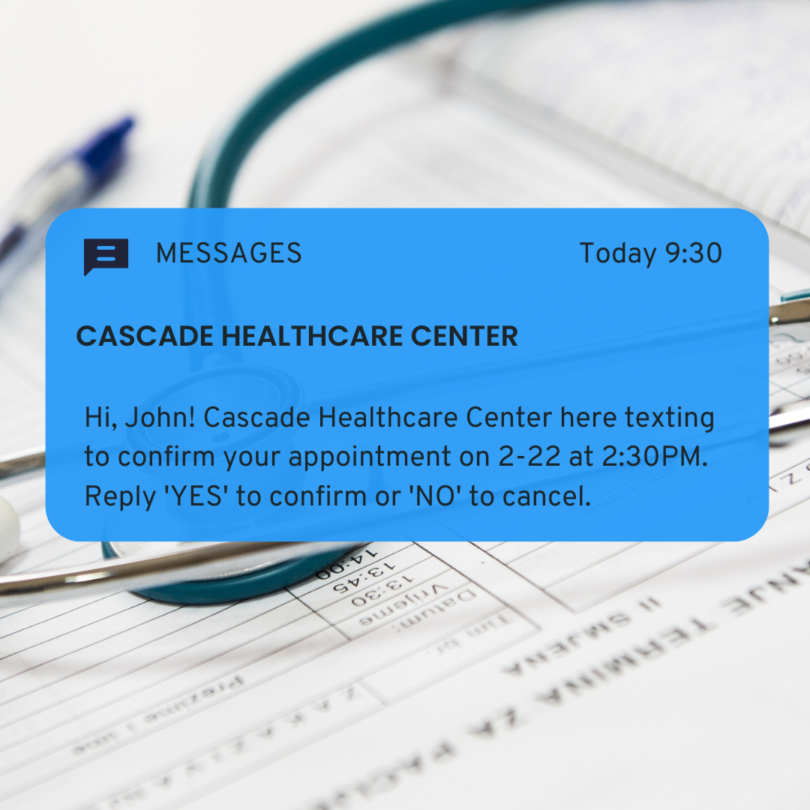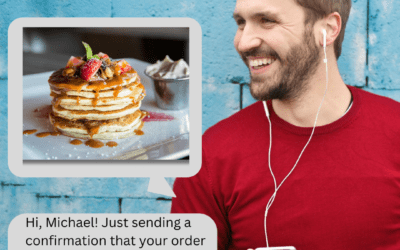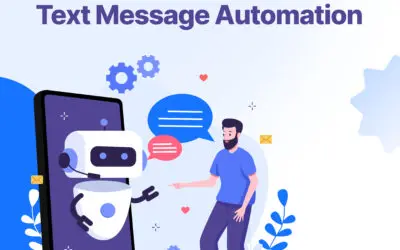Text Messaging (SMS) for Healthcare Providers
Healthcare facilities are omnifarious workplaces around the clock – from walk-ins, paperwork filing, and most importantly, taking good care of patients. With SMS for healthcare, providers can focus less on communication logistics and more on ensuring the patients’ treatment and well-being.
SMS is the gateway for reliable messaging, which is why so many healthcare organizations around the world are adopting text to communicate with patients, doctors, staff, and stakeholders.
Why should healthcare providers use SMS?
Emails are a great way to reach a broad audience but don’t match the effectiveness of SMS messages. More specifically, emails can easily end up in the spam box or sit unnoticed for extended periods – rendering this method unreliable and an impediment to the high responsiveness expected in a hospital environment.
Fast
Text messages are the fastest way to connect with patients, yielding an average open rate of 98%; furthermore, SMS messages typically get opened within 3 minutes of being sent. It enables healthcare providers to instantly reach many patients with updates on new services or changes within the practice. These statistics prove the text’s superior efficacy in fundamental medical-related communication.
Personal
SMS lets you get personal with your communication by connecting with patients on the same familiar channel they use for everyday chats and check-ins. Most patients who have received SMS updates from their healthcare providers have reported feeling more connected to their care teams. Specifically, 95% of patients noted increased connection when receiving these updates.
Control
People can opt in or out of campaigns, giving them total control over the messages they receive. If a patient is no longer active within a facility, they can dismiss future alerts with the push of a button.
Monitor
SMS campaigns are easy to manage and monitor because of permission-based capabilities, enabling users to send messages to a specified contact at the exact set time.
Cost-Effective
Rather than sending letters or brochures through the mail, leverage SMS for direct, immediate, and cheap marketing with embedded links to relevant information.
Accessibility
Text messages don’t require an internet connection; individuals still get important medical-related information with just a cellular signal. Text messaging facilitates improved communication, strengthening patient relationships and increased patient retention.
Who will benefit?
Time and information are key to a collaborative, agile work environment. With patients ebbing and flowing through waiting rooms, keeping communication airtight is essential to avoid workflow idles. When it comes to keeping hospital staff updated, SMS healthcare solutions are invaluable. Staff members can quickly receive important information via SMS, ensuring they are always informed. From sharing schedule updates to sending key reminders directly to their phones, staff can stay connected and updated on the latest developments.
Hospitals contain certain groups of people responsible for the cohesion of all sections so that they may operate in unison. In emergencies or general announcements, the entire hospital community can benefit from timely alerts directly to everyone’s on-the-go communication medium.
Healthcare providers
Healthcare providers can realize the advantages of SMS for multiple purposes, such as department meetings, appointments, reminders, prescriptions, seminars, and so forth.
Patients
Patients can receive upcoming appointment reminders with message alerts directly on their smartphones. This will help reduce no-shows and encourage early arrivals for pre-visitation intake procedures.
Travelling nurses
Have sub-nurses filling in at your facility? Get them in the loop and make them part of the team instantly with a detailed list of expected actions upon arrival and throughout their sojourn – helping to maintain a staff abounding in agility, insight, and harmony.
Janitors
Have a sudden fluctuation of patients coming into the facility? Notify your intendant of the onslaught so that they can plan their sanitation interventions accordingly.
Pro tip: Keep a strong relationship with your patients and reach out regularly with wellness tips – follow up post-visit to see how they’re doing.
How you can use SMS for healthcare
Knowledge is indispensable to manage a medical facility properly. SMS can be leveraged to disseminate information promptly for multiple use cases and prepare individuals for dynamic, unprecedented circumstances.
Appointments
Give users the ability to schedule new appointments, then inform them about their upcoming visitations directly to their smartphones.
Job openings
Demand varies seasonally; update job-seekers about current listings and when it comes time for an interview, send them an SMS reminder.
Prescriptions
Timing prescription pickups can be frustrating and inconvenient. With text alerts, patients will know precisely when their prescriptions are filled and where to go for pickup.
General announcements
With the upsurge of COVID-19 cases around the world, citizens are anxious to learn about local outbreaks. Update the community about the rise and fall of cases so that they can plan accordingly. Soon, vaccination alerts will be coming your way, too!
Test results
Test results can often take hours or days. With SMS, send your patients results with a secure link so that they can take action accordingly.
Patient feedback
Surveys are a great way to improve facility well-being, from patient health, seminars, or even today’s cafeteria menu. Simply send them an SMS and get feedback instantly with fresh opportunities for improvement.
Shift coverages
Need to get a shift covered? No worries – reach your entire staff with SMS and find somebody to fill the empty space in minutes.
Guess what?: 48% of consumers say that they prefer to be notified via text message; with email as the runner-up at 22%.
What devices are compatible?
Any device that can receive a message to a unique 10-digit phone number is eligible to opt-in to your SMS campaigns.
This can also include messaging apps such as Google Voice that enables you to create a phone number. The shortcoming to a Google Voice number is that messages can only be received with an internet connection.
How SMS for healthcare works
We broke down the process step-by-step so you can precisely and confidently conduct successful SMS campaigns. With the proper strategy, text alerts can help strengthen your healthcare facility by putting knowledge at the forefront of all facility activities.
Implementing SMS within healthcare organizations without costly hardware or extensive training can be achieved effortlessly. This approach requires no expensive hardware investments and eliminates the necessity for complex training sessions. Since most patients and staff members already possess and regularly use cell phones with SMS capabilities, implementing SMS is seamless and does not require users to download additional apps.
1. Who will manage the SMS campaigns?
Managing an SMS campaign for company-wide communication requires careful consideration. Many healthcare facilities hire a dedicated communications manager for the task. If this isn’t an option for your establishment, you could seek the assistance of a receptionist.
2. Get familiar with the TCPA policy
The individual coordinating the outreach should be familiar with the TCPA Policy for SMS communication within a healthcare organization. The TCPA policy is a set of regulations that govern the quantity of phone calls and messages sent on a day-to-day basis.
To ensure full compliance, your organization should establish quarterly practices and comprehensively comprehend the latest TCPA guidelines.
Learn more about the TCPA policy here.
3. HIPAA Regulations and Patient Privacy
Doctors need to be aware of several laws and regulations regarding healthcare and texting. One of the key laws governing this area is the Health Insurance Portability and Accountability Act (HIPAA), which encompasses the HIPAA Privacy Rule and Security Rule. The HIPAA Privacy Rule dictates how Protected Health Information (PHI) can be shared without a patient’s consent. At the same time, the Security Rule establishes safeguards to ensure only authorized individuals can access this information. To comply with HIPAA when texting patients, healthcare providers must ensure they have obtained patient consent and use a secure platform that encrypts data.
4. What information will be used?
Before you start sending SMS campaigns to your audience, you need to identify which details you plan to share with your audience. We suggest starting small and scaling upwards.
Perhaps start with a survey asking patients which information they would like to receive. After you get a feel for the basics, gradually increase the information sharing output.
5. Facilitation of information
Your medical center should establish an efficient information tree that ensures the person managing communication has the proper data before sending campaigns. As medical information must be protected at all times, messages must be encrypted when in transit.
6. Ability to opt-in and opt-out of campaigns
You need to get their approval to include people in your SMS campaigns. The easiest way to get patients to opt-in is during registration. Alternatively, if you’re already an established healthcare facility and have an existing client base, you can invite users to opt-in via email, during visits, and over the phone.
As individuals can opt-in, they also need the ability to opt-out. This should be made accessible to people by using keywords such as “Reply STOP to stop”. When they reply using a dedicated keyword, they will be opted-out of any further campaigns until stated otherwise.
Providers should consider sharing their texting numbers in various strategic locations to maximize patient accessibility. This includes informing them during practice visits, sending informative emails, and making the number easily accessible by posting it online and in physical locations. To ensure patients can easily find your texting number, it is recommended to share it on your website, social media profiles, review pages, digital advertisements, and printed materials.
7. Sending the campaign
Last, the most important part is the campaign!
Your healthcare facility should be conscious of the number of messages it shares with its community. If messages arrive several times daily, users will likely opt out of campaigns. The TCPA policy restricts this kind of activity.
A good rule of thumb is 2-4 texts per month unless important or urgent information must be shared.
Note: In SMS marketing, less is more. SMS only enables you to send up to 160 characters – make those characters count!
SMS platform for healthcare providers
Cloud Contact AI streamlines SMS marketing, helping you reach your audience wherever they are. Our customer communication platform is designed to foster meaningful and reliable relationships with patients for healthcare facilities of all sizes.
2-Way Communication
With CCAI’s innovative inbox, you can chat back and forth with patients in 2-way conversations, making appointment scheduling effortless.
Mass Messaging
Engage with patients on a company-wide level, rather than one-by-one messages.
Scheduled Messages
Stay ahead of your schedule by programming messages minutes, hours, days, or months in advance to ensure that patients are aware of and on time for their appointments.
Import Contacts
Upload contacts one by one or in bulk in seconds. You can also create contact lists to distinguish between groups or campaigns.
Multi-Number
Create and designate multiple numbers for unique departments, regions, and profiles to easily manage and sort your communication.
Keyword & Short Code
To receive general announcements, encourage members to message you with a unique keyword or shortcode. It is essential to consider a multi-faceted approach. This includes informing patients during their visit, sending emails, and making the business texting number publicly available online and in physical locations. It is crucial to share this number across various platforms such as websites, social media profiles, review pages, digital advertisements, and printed materials to ensure patients have easy access to this communication channel.
Templates
Prepare for certain situations and create templates in advance so that the message preparation part is done; you just have to choose who to send it to.
Pay-as-you-go
With CCAI, you don’t have to worry about being charged for the time you’re not using the platform. Only pay for the messages that have been sent.
Dynamic Tags
Create a personalized experience and use dynamic tags to make your messages more sincere – proven to yield higher engagement rates.
Sub-accounts
With sub-accounts, hospitals can categorize campaigns by department or location for clear, concise communication.
How to begin
Cloud Contact AI offers a 14-day free trial period so that you can test all of the unique features and see if CCAI is a right fit for you. Try out unlimited messages on us for two weeks with no up-front credit card or contracts required.
1. Sign up on CCAI
Navigate to Cloudcontactai.com and click Sign Up in the header.
2. Upload Contacts
Select Contacts in the left-hand menu and upload contacts one-by-one or as a group in CSV format.
3. Create a campaign
Click SMS in the menu and begin your mass outreach.
4. Support
Need help getting set up? Shoot us an email; we are happy to assist you!
Not sure if you’re ready to revolutionize the way your healthcare office communicates? Sign up for our 14-day free trial!
What do you have to lose?




